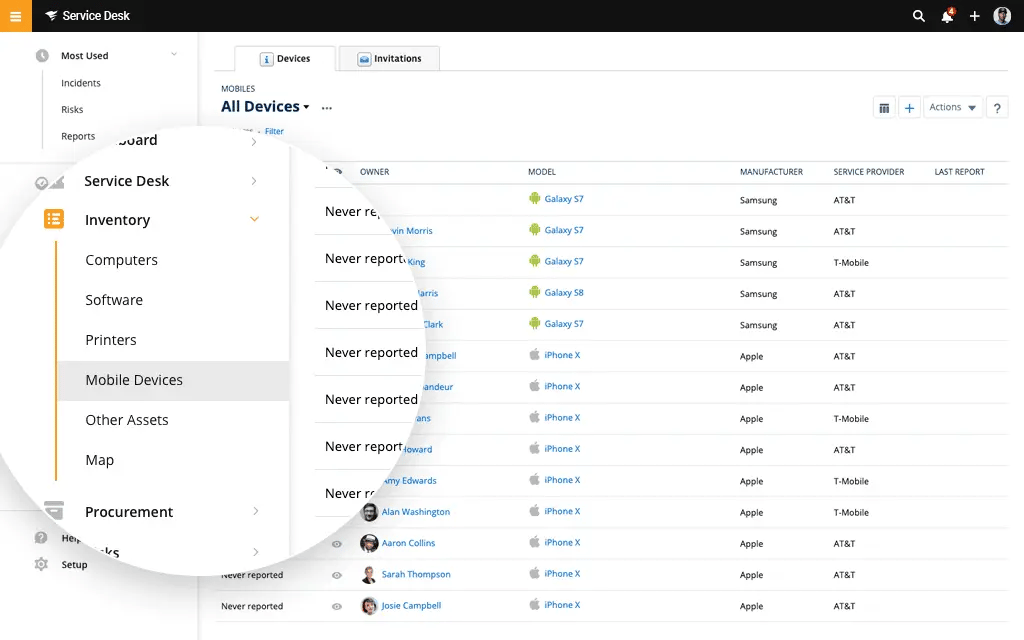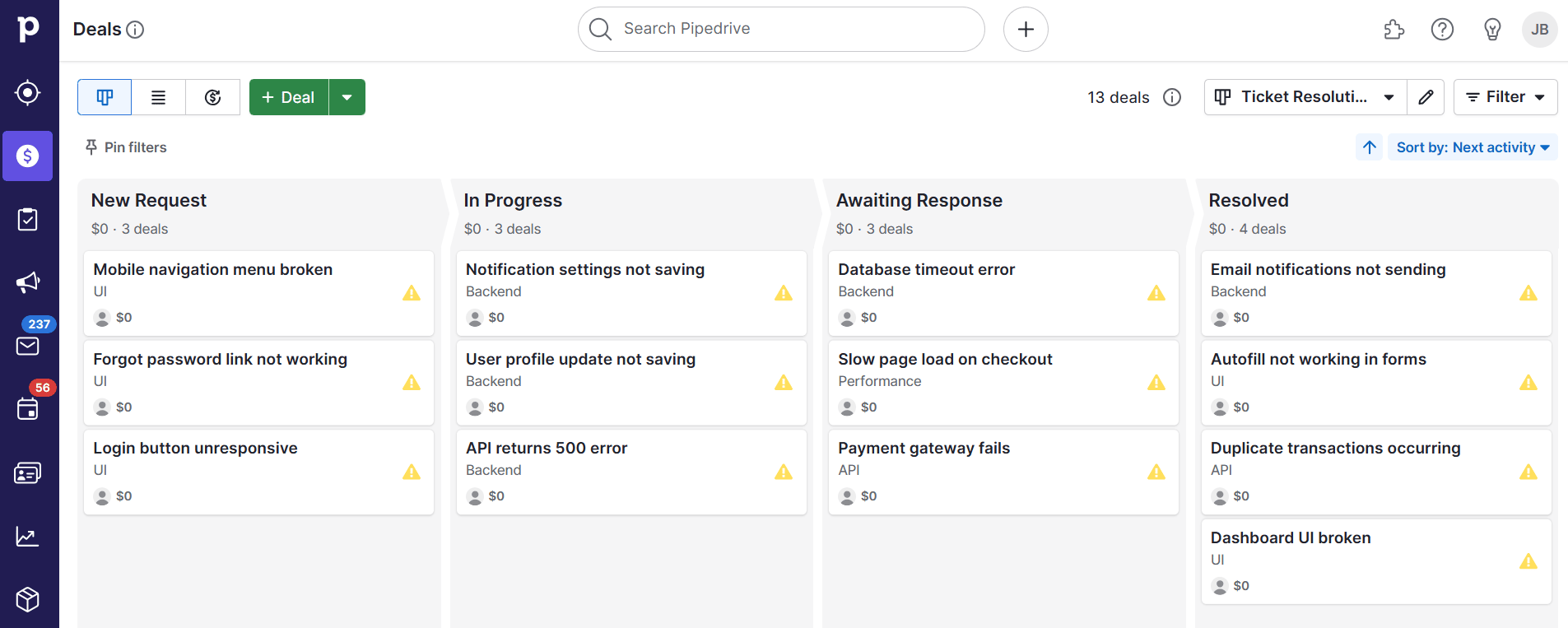IT management software helps business owners and IT professionals manage a company’s in-house IT function.
The technology supports every aspect of IT management, helping companies improve operational efficiency and strengthen security.
In this article, you’ll learn about the best IT management software for in-house teams and the benefits each tool offers. If you’re not quite ready to invest in dedicated IT management software, you’ll discover how to use your CRM as an alternative solution.
What is IT management software?
IT management software allows companies to run their in-house IT functions efficiently and securely.
The software ensures that companies comply with relevant policies and regulations. It also supports smooth day-to-day IT operations.
There are four main categories of IT management software for in-house teams:
Remote management and monitoring (RMM) software
Asset management software
Endpoint management software
IT service management (ITSM) software
We’ll discuss each category in further detail later in the article.
Today, most IT management software solutions are cloud-based. They offer users flexible, remote access from any internet-enabled device.
What are the top features of IT management software?
Although there are different types of IT management software, the best solutions all share the following features:
Automation of routine IT tasks | AI-powered software streamlines repetitive IT processes so IT teams can focus on strategic tasks. |
Compliance and security support | Comprehensive software automates policy enforcement, data protection and auditing to help companies comply with regulations and meet industry standards. |
Centralized functionality | Top solutions consolidate multiple IT functions into a single platform, providing a seamless user experience and a single source of truth. |
Real-time monitoring and reporting | The best cloud IT management software tools monitor a company’s IT infrastructure to deliver real-time notifications and data-driven analytics. |
Cross-platform and multi-device support | Top IT management software supports multiple operating systems and devices, including desktops, laptops and smartphones. |
Scalability for growing businesses | The software scales with a business as it grows, allowing companies to add new devices, users and locations. |
Now you’ve learned the top features of IT management software, it’s time to discover the 12 best IT management tools.
The 12 best IT management software tools
Here are the 12 best IT management tools for in-house IT teams and a summary of their standout features.
App | Standout features |
Rippling IT |
|
Syncro |
|
Atera |
|
Deel IT |
|
Solarwinds Observability |
|
Josys |
|
NinjaOne |
|
ManageEngine Endpoint Central |
|
Hexnode |
|
FreshService |
|
Jira Service Management |
|
ServiceNow IT Service Management |
|
Now that you have some insight into the best IT management platforms and their most helpful features, let’s look at each tool in greater detail and by type.
Best remote IT management software
Remote monitoring and management (RMM) software allows companies to remotely control and manage their IT systems.
RMMs facilitate remote access and troubleshooting, automated patch management and real-time performance monitoring.
Solutions often include mobile device management (MDM) functionality. MDM allows companies to control and secure their mobile devices.
Here are three comprehensive RMMs.
Rippling IT

Rippling IT is the IT component of Rippling’s employee management software.
The software provides comprehensive RMM support through the following features:
Unified device and software management. Manage employee devices and software access from a single dashboard, working efficiently from a single source of truth.
Automated onboarding and offboarding. Give new hires instant access to the systems they need and revoke access as soon as they leave.
Security and compliance enforcement. Audit and enforce policies like two-factor authentication (2FA) and mandatory software updates without manual checking.
Rippling’s Human Capital Management (HCM) software integrates with Pipedrive. The integration allows business owners and IT professionals to manage employee accounts in Pipedrive. For example, when a new salesperson joins, Rippling automatically creates a Pipedrive account for them.
Syncro

Syncro is an integrated IT management software solution for IT teams and managed service providers (MSPs).
Its RMM functionality includes the following helpful features for in-house IT functions:
Customizable automated scripting and patch management. Write custom scripts aligned to business needs in PowerShell, CMD or Python scripts and then schedule the patch deployment.
Integrated remote access and support. Provide remote employee assistance and switch between devices in different locations using Syncro’s built-in integration with the remote desktop application Splashtop.
Policy-based monitoring and automation. Monitor activity and automate responses to policy breaches automatically based on specific triggers (e.g., restart a service automatically if it crashes).
Syncro also provides professional services automation (PSA) software to help companies manage their business operations. PSA software usually supports tasks like time tracking, invoicing and billing.
Atera

Atera is an AI-powered IT management solution with a broad range of functionality for in-house IT functions and MSPs.
Its RMM functionality helps IT teams control and manage systems remotely in the following ways:
AI-powered IT automation. The software automates routine maintenance and monitoring tasks using artificial intelligence and machine learning algorithms, saving IT teams time.
Pay-per-technician pricing model. With Atera, costs scale based on the number of IT staff using the system, making it an affordable option for small businesses and IT teams.
Built-in remote monitoring and alerts. Atera monitors device performance across the workforce, detecting issues early and sending instant alerts so IT teams can take preventive action.
Atera also provides IT service management software with AI-powered ticket tagging functionality.
Best online asset IT management software
Online asset IT management software allows companies to track and manage their IT hardware inventory.
This inventory usually includes desktop computers, laptops and mobile devices. In some cases, it also includes the company’s SaaS (software as a service) assets. These might consist of licenses and subscriptions to SaaS products.
Asset management solutions often include device lifecycle management (DLM) functionality, which helps users manage the company’s devices through their lifecycle.
Here are three comprehensive IT asset management solutions.
Deel IT

Deel IT is the IT management software solution from Deel, a global HR and payroll platform. It focuses on supporting global IT operations.
The software offers robust asset management support through the following features:
Global device procurement and deployment. Order, ship and manage IT assets for employees around the world with Deel IT’s full-service hardware provisioning solution.
Automated offboarding and device retrieval. Use Deel’s logistics support for device return, repurposing and disposal to handle employee offboarding quickly and securely.
Built-in compliance and security controls. Ensure compliance with privacy and security laws – like the General Data Protection Regulation (GDPR) in the EU – when issuing or reassigning devices.
Deel IT can also help in-house IT teams diagnose and resolve problems with company devices and recondition and reuse hardware.
Solarwinds Observability

Solarwinds Observability gives companies complete visibility of their cloud-based, on-premises and hybrid IT assets (or “tech stacks”).
The platform includes a well-rounded set of asset management features for in-house IT teams, including:
Comprehensive IT asset discovery and monitoring. The software provides real-time inventory management and performance tracking, automatically detecting, cataloging and monitoring a company’s IT assets.
Predictive maintenance and performance analytics. AI-driven analytics predict future problems, alerting IT teams to potential issues like storage capacity shortages before they happen.
Automated compliance and risk management. The system tracks IT assets for compliance purposes, ensuring all company laptops meet industry regulations like encryption standards.
Solarwinds Observability also includes open-source database performance monitoring. This monitoring can increase system performance and help companies save on IT infrastructure costs.
Josys

Josys is a SaaS management platform that allows companies to consolidate and manage all their SaaS apps, licenses and users.
For IT teams managing a large SaaS-based asset inventory, the software offers a wide range of helpful features, including:
Automated software license management. Automate routine SaaS management tasks like subscription renewals.
Detailed SaaS visibility and usage tracking. Get complete visibility into SaaS usage across the company to help IT teams reduce wasted spending.
Automated employee onboarding and offboarding workflows. Fully automate user provisioning and de-provisioning across SaaS tools so the system grants access when new hires join and deactivates accounts when employees leave.
Josys integrates with a wide range of business-critical applications like Slack, Zoom and Asana, allowing IT teams to streamline workflows even further.
Catch more hot leads before they bounce
Best endpoint management software
Endpoint management software allows users to secure all connected devices (or “endpoints”) to the company’s network. It then allows companies to monitor these devices. Examples of endpoints include desktop computers, laptops and mobile devices.
Endpoint management ensures that devices are configured correctly, secure and compliant with company policy. The software usually includes patch management, network management and network monitoring functionality.
Most platforms work across various devices and on multiple operating systems, including Windows, MacOS and Linux.
Here are three examples of robust endpoint management software solutions:
NinjaOne

NinjaOne is an endpoint management and RMM platform.
It offers a wide range of features to support in-house IT teams, including:
Automated endpoint configuration deployment. The software automates the deployment of specific configurations like security settings, improving consistency and reducing human error.
Role-based access control (RBAC) for endpoints. This feature restricts access to endpoints based on users’ job roles to reduce security risks.
Real-time endpoint monitoring and reporting. The platform provides real-time visibility of endpoint performance, helping IT teams work proactively and identify potential issues early.
NinjaOne also includes customizable alerting and escalation rules. This feature lets IT teams define alert thresholds and escalation workflows for endpoint issues.
ManageEngine Endpoint Central

ManageEngine Endpoint Central is the endpoint management solution from ManageEngine.
The platform offers comprehensive support for endpoint management through the following functionality:
Endpoint privilege management. The software grants or restricts device admin rights to reduce malware risks and prevent unauthorized software installation.
USB and peripheral device control. The system manages access to endpoints like USB drives, printers and external storage to protect against data leaks and potential security threats.
Real-time endpoint security enforcement. The software enforces real-time security policies (e.g., encryption requirements and access control measures) on endpoints to ensure compliance with security standards.
ManageEngine Endpoint Central can also automate the deployment of approved applications to endpoints. Automating deployment ensures IT teams have the necessary software to maintain security and compliance.
Hexnode

Hexnode is a unified endpoint management platform.
The software supports endpoint management for in-house IT teams through the following functionality:
Policy-based device compliance. The software enforces security policies through restrictions on operating systems, app installations and device features to minimize risk and vulnerabilities.
Network access control for endpoints. The system only allows devices that meet predefined security requirements to connect to the corporate network, minimizing risk further.
Advanced endpoint auditing and reporting. The platform provides detailed logs and reports on device activities like application usage and security incidents.
Hexnode also offers a comprehensive mobile device management (MDM) solution.
Best IT service management software
IT service management (ITSM) software facilitates IT customer support and service delivery. It primarily does this through ticketing and workflow management.
The software allows IT departments to run in-house help desks. It also helps them respond to service requests from colleagues.
IT service management solutions usually include functionality for end-users to self-serve, allowing users to resolve straightforward IT issues independently.
Some systems include project management features. Companies sometimes use the software instead of a project management information system (PMIS).
Here are three examples of comprehensive IT service management software.
FreshService

FreshService is an AI-powered ticketing platform for IT service delivery.
It provides comprehensive ITSM support through the following features:
Incident and service request management with SLA tracking. The software manages and tracks IT incidents and service requests to minimize downtime and ensure compliance with service level agreements (SLAs).
Automated workflows and ticket routing. Freshdesk automatically assigns tickets to the appropriate team or individual based on predefined rules, reducing manual effort and improving efficiency.
Customizable Knowledge Base integration for self-service. The system includes an integrated Knowledge Base, which IT teams can customize to help employees self-serve and resolve common IT issues.
FreshService also integrates with key enterprise apps like Microsoft Teams and Slack to make IT service management easier and more efficient.
Jira Service Management

Jira Service Management is the IT service management platform from Atlassian.
The AI-powered platform includes a wide range of ITSM functionality, including:
End-to-end incident, problem and change management. The software allows IT teams to track and resolve incidents quickly, analyze their root causes and implement fixes from a single platform.
Seamless collaboration between IT and development teams. Through deep integrations with Atlassian’s other tools, including Jira Software and Confluence, the platform helps IT teams and developers work on fixes together.
Customizable workflows and automation. The system allows IT teams to create tailored workflows for managing support queries and automating repetitive tasks like ticket prioritization.
Jira Service Management also includes an AI-powered virtual agent feature that helps IT teams provide quicker and more efficient service.
ServiceNow IT Service Management

ServiceNow IT Service Management is an AI-driven ITSM platform.
The software provides comprehensive ITSM support to in-house IT teams through the following functionality:
AI-powered incident management with predictive analytics. Using AI and machine learning algorithms, the software automatically resolves incidents and routes tickets to the right team based on previous data.
Comprehensive change and release management. The system streamlines the planning, approval and deployment of system changes to reduce the risk of system failures and service interruptions.
AI-powered incident resolution. The software uses AI to analyze incidents in real time and predict recurring issues, helping users identify potential problems in the IT environment and take preventative action.
ServiceNow IT Service Management also includes an AI-powered virtual agent for IT support. It provides automated, intelligent responses to common IT issues. This feature helps to reduce service desk workload and improve response times for end users.
What are the benefits of IT management software?
Here are five ways that IT management software can optimize the productivity and performance of in-house IT functions:
1. Improving efficiency and optimizing workflows
The software reduces manual work for IT teams by automating repetitive tasks so they can focus on strategic activities and high-value projects.
The software also helps teams create optimized workflows and streamline processes across departments, resulting in smoother day-to-day business operations.
2. Strengthening security and compliance
IT management software helps ensure company systems comply with industry standards and regulations.
IT teams can use the software to enforce security policies, like enabling two-factor authentication (2FA). The software can also help IT teams take prompt action against risks. For example, it can revoke access after detecting an unauthorized login attempt.
These measures reduce vulnerabilities in the IT ecosystem. They also help to protect companies from cybersecurity threats.
Crush your manual admin with this sales automation guide
3. Improving visibility and control for IT teams
Most cloud IT management software tools deliver real-time insights through centralized dashboards. The dashboards allow them to see the status of the company’s systems, devices and software in a single place.
This visibility allows IT experts to monitor performance and identify potential issues quickly.
4. Supporting companies as they grow
Top IT management software can scale with a company as it grows. The systems’ monitoring and management capabilities support distributed or remote teams.
As a company grows, IT professionals can manage the IT ecosystem across multiple locations, allowing them to deliver a consistent service to everyone in the business.
5. Providing companies with valuable data-driven insight
IT management software analyzes the performance of company systems and devices. The analysis provides actionable insights for IT professionals to identify trends and optimize resources.
The insight can also help business owners make informed decisions about budget allocation.
How to use your CRM as IT management software
If you’re already using a CRM like Pipedrive to track sales and marketing activities, you can set up a pipeline to track and automate IT tasks.
In Pipedrive, you can use the software’s pipeline management functionality to do this.
To use Pipedrive for IT support ticket tracking, add a new pipeline to your Pipedrive account. Then, customize the pipeline stages to reflect the ticket resolution process. For example, you might create stages for “New requests”, “In progress”, “Awaiting response” and “Resolved”.

You can then set up automated reminders to update IT team members about each ticket. For example, Pipedrive can send an alert if a task is unresolved after a certain number of hours or days.
Pipedrive can also help with software license management. It can send automated alerts when licenses are due for renewal.
For small businesses with tight budgets, using a CRM for startups might be the best step before investing in IT management software.
Download Your Sales and Marketing Strategy Guide
Final thoughts
IT management software can help business owners and IT professionals run smooth and secure in-house IT functions.
From AI-powered automations that save time to real-time monitoring, the products offer powerful functionality. For small businesses and startups, CRMs provide a cost-effective alternative.
The pipeline management functionality in Pipedrive’s CRM allows users to track IT support tickets. It can also automate activities like ticket assignment and software license management.
Sign up for a free 14-day trial to see how Pipedrive can help you track, manage and automate your IT management activities.







